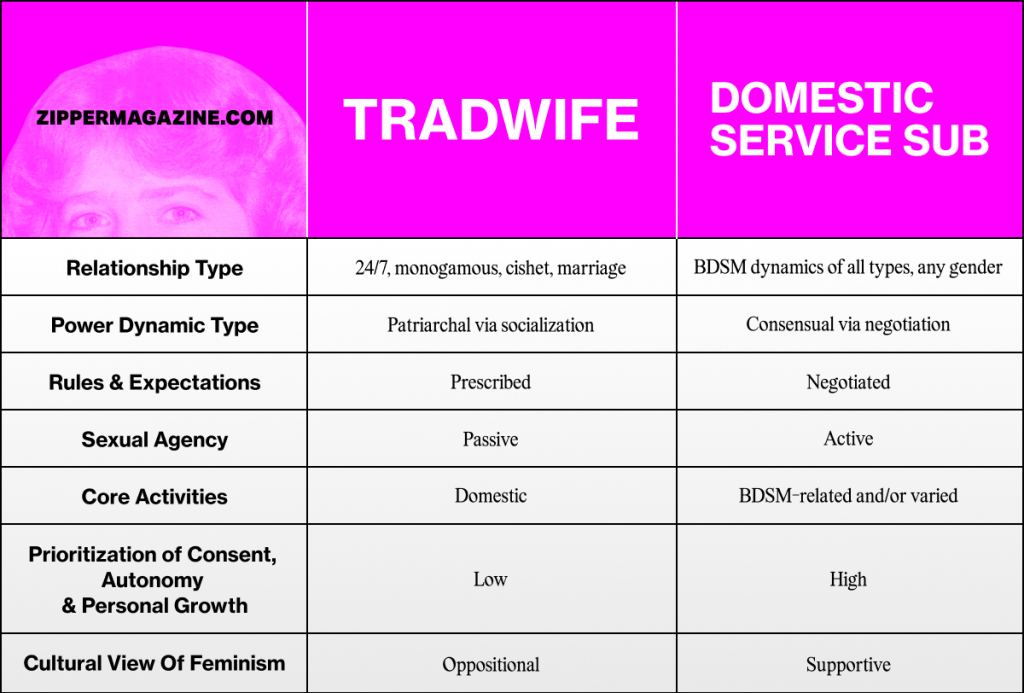
Your Favorite Kinks & Weirdest Fetishes – Kinky Census
What are the most popular kinks? Weirdest fetishes? What if you’re not into your partner’s kinks? Are there more tops or bottoms? Watts The Safeword’s Kinky Census has the answers!
By Sunny Megatron

On the surface, tradwives and domestic subs appear similar. They both center around submission within a power-exchange dynamic. But look a little deeper and you’ll find some fundamental differences.
Short for “traditional wife,” a tradwife is a woman who adheres to ultra-traditional gender roles in monogamous marriage. This typically includes things like domestic tasks, prioritizing her husband’s career, and submitting to male leadership. Tradwives typically view their submissive role as a natural part of their gender and identity. Many take that further believing that submission should be a part of every ciswoman’s identity.
Beyond describing a lifestyle choice based on 1950s-era family values, the term tradwife has been embraced by a growing movement & subculture within far-right extremist communities.
These are individuals who, regardless of gender or relationship style, enjoy submitting to their power-exchange partners in a domestic context. This flavor of service submissive may find fulfillment in household tasks like cooking and cleaning and derive pleasure from serving, pleasing, and supporting their dominant partner.
Domestic service submissives may also enjoy role-playing domestic scenes and adopting traditional domestic and gender roles. Some bring behaviors, social norms, and aesthetics of 1950s housewives into their BDSM dynamic and/or play too.
Not all domestic subs play by one universal rulebook. Their dynamics range from casual to serious, are consensually negotiated between partners, and are customized to serve everyone’s needs. Additionally, some may view their submissive role as more of a fetish or kink while others embrace it as a part of their core identity.
One of the biggest differences between Tradwifery and domestic-oriented D/s dynamics in kink is the level of consent involved and how it’s prioritized. Tradwives often enter into submissive relationships without fully understanding the power dynamics at play, and may not have the same level of agency as their kinky counterparts. Adherence to certain rules and expectations may also be required with no regard for their personal boundaries and needs.
In contrast, submissives in BDSM typically enter into their relationships with a clear understanding of the rules and boundaries. They have a greater say in how their relationship operates, can opt-out (partially or completely), and are free to renegotiate rules and prior agreements to better suit their desires.
In other words, in kink consent is not only prioritized, it’s a fundamental part of the culture and framework of BDSM. Consent tools like safewords, check-ins, and scheduled renegotiation are expected to be used in dynamics and scenes too.
As a BDSM educator and kinkster, I have a hunch that some women are drawn to the tradwife lifestyle because it satisfies a kink that they don’t even know they have. How can you tell if you’re curious about tradwifery due to its resemblance to consensual BDSM or not? This may help you out:

Note: This chart generalizes common beliefs & trends to provide a broad overview. It doesn’t reflect the individual experiences or nuanced views of those who identify as BDSM submissives or tradwives.
Sharing is caring

Sunny Megatron
Sunny Megatron is an award-winning BDSM & Certified Sexuality Educator, Certified Relationship Coach, and media personality. She’s the host and executive producer of the Showtime original television series, SEX with Sunny Megatron, plus co-hosts AASECT Award-winning American Sex Podcast and Open Deeply Podcast. Sunny was also named XBIZ Sexpert of the Year 2021 and is Editor-in-Chief of Zipper Magazine.
Known for her one-of-a-kind build-your-own-adventure approach to sex, kink & relationships, Sunny coined the BDSM community catch-phrase, Kink is Customizable™. In her sell-out workshops, her unique brand of “edutainment” seamlessly combines her humorous lecturing style, interactive exercises, and the latest sexuality research. Sunny’s passion is helping others overcome shame and find power through play and pleasure. Currently, she’s working on her first book, “Customizable Kink: A Strategic Guide to Adult Play.”
You can find Sunny Megatron on TikTok, Twitter, Instagram, Facebook, and Patreon.
READ NEXT

What are the most popular kinks? Weirdest fetishes? What if you’re not into your partner’s kinks? Are there more tops or bottoms? Watts The Safeword’s Kinky Census has the answers!

We’ve teamed up with The Stockroom for an electrifying Valentine’s Day kink gear giveaway: a Kinklab Neon Wand® Electrosex Kit & Power Tripper Attachment! This versatile set has something for everyone from sensual to extreme. Enter daily for more chances to win.

Munches are a great way to get to know people in your local kink scene. Find out the difference between a munch & slosh, what to wear, essential munch etiquette, how to find online munches, and why building platonic connections within the community is key.

Lifestyler and Pro-Dominant, Miss Maya Sinstress, tells us about her love of cuckolding, the unexpected way she got into the fetish, complimentary kinks, consent & communication, plus she gives advice for cuck-curious kinksters looking to bring their fantasies to life.